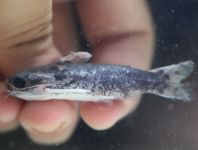Abstract
Thirty years after its first finding and description, the marine cave stenopodid shrimp Odontozona addaia is here reported for the second time. The new localities, particular marine caves of southern France, are more than 300 km apart from the type locality in the Balearic Islands. First live in situ photographs are provided, and the morphological intraspecific variability is detailed by comparing the new specimens to the types. DNA sequences were also obtained for comparison with other Odontozona species. Based on both morphology and molecular analysis, closest relatives of O. addaia appear to be the western Atlantic Odontozona meloi and the eastern Mediterranean Odontozona minoica, although their detailed relationships remain unresolved.
References
Anker, A. & Tavares, M. (2013) Description of a new deep-water stenopodid shrimp of the genus Odontozona Holthuis, 1946 (Crustacea, Decapoda) from Brazil. Marine Biology Research, 9, 421–430.
https://doi.org/10.1080/17451000.2012.745004
Bakran-Petricioli, T., Vacelet, J., Zibrowius, H., Petricioli, D., Chevaldonné, P. & Rada, T. (2007) New data on the distribution of the “deep-sea” sponges Asbestopluma hypogea and Oopsacas minuta in the Mediterranean Sea. Marine Ecology—An Evolutionary Perspective, 28 (Supplement 1), 10–23.
https://doi.org/10.1111/j.1439-0485.2007.00179.x
Bochini, G., Cunha, A.M., Terossi, M. & Almeida, A. (2020) A new genus and species from Brazil of the resurrected family Macromaxillocarididae Alvarez, Iliffe & Villalobos, 2006 and a worldwide list of Stenopodidea (Decapoda). Journal of Crustacean Biology, 40 (6), 704–714,
https://doi.org/10.1093/jcbiol/ruaa064
Calado, R., Chevaldonné, P. & dos Santos, A. (2004) A new species of the deep-sea genus Bresilia (Crustacea: Decapoda: Bresiliidae) discovered from a shallow-water cave in Madeira. Journal of the Marine Biological Association of the U.K., 84, 191–199.
https://doi.org/10.1017/S0025315404009051h
Cárdenas, P., Vacelet, J., Chevaldonné, P., Pérez, T. & Xavier, J.R. (2018) From marine caves to the deep-sea, a new look at Caminella (Demospongiae, Geodiidae) in the Atlanto-Mediterranean region. Zootaxa, 4466 (1), 174–196.
https://doi.org/10.11646/zootaxa.4466.1.14
Chen, C.L., Goy, J.W., Bracken-Grissom, H.D., Felder, D.L., Tsang, L.M. & Chan, T.Y. (2016) Phylogeny of Stenopodidea (Crustacea : Decapoda) shrimps inferred from nuclear and mitochondrial genes reveals non-monophyly of the families Spongicolidae and Stenopididae and most of their composite genera. Invertebrate Systematics, 30, 479–490.
https://doi.org/10.1071/IS16024
Chevaldonné, P. & Lejeusne, C. (2003) Regional warming-induced species shift in north-west Mediterranean marine caves. Ecology Letters, 6, 371–379.
https://doi.org/10.1046/j.1461-0248.2003.00439.x
Chevaldonné, P., Sket, B., Marschal, C., Lejeusne, C. & Calado, R. (2008) Improvements to the “Sket bottle”: a simple manual device for sampling small crustaceans from marine caves and other cryptic habitats. Journal of Crustacean Biology, 28, 185–188.
https://doi.org/10.1651/07-2923R.1
Chevaldonné, P., Rastorgueff, P.A., Arslan, D. & Lejeusne, C. (2015) Molecular and distribution data on the poorly-known, elusive, cave mysid Harmelinella mariannae (Crustacea: Mysida). Marine Ecology, 36, 305–317.
https://doi.org/10.1111/maec.12139
Dounas, C. & Koukouras, A. (1989) Odontozona minoica, new species, from the Eastern Mediterranean sea (Decapoda: Stenopodidea). Journal of Crustacean Biology, 9, 341–348.
https://doi.org/10.2307/1548509
Fourt, M., Goujard, A., Pérez, T. & Chevaldonné, P. (2017) Guide de la faune profonde de la mer Méditerranée. Patrimoines Naturels. Vol. 76. Muséum national d’Histoire naturelle, Paris 184 pp.
Gönülal, O., Sezgin, M. & Öztürk, B. (2014) New records of decapod crustaceans from the deep Aegean Sea of Turkey. Crustaceana, 87, 1461–1468.
https://doi.org/10.1163/15685403-00003358
Guindon, S., Dufayard, J.F., Lefort, V., Anisimova, M., Hordijk, W. & Gascuel, O. (2010) New algorithms and methods to estimate Maximum-Likelihood phylogenies: Assessing the performance of PhyML 3.0. Systematic Biology, 59, 307–321.
https://doi.org/10.1093/sysbio/syq010
Hall, T.A. (1999) BioEdit: a user-friendly biological sequence alignment editor and analysis program for Windows 95/98/NT. Nucleic Acids Symposium Series, 41, 95–98.
Harmelin, J.G., Vacelet, J. & Vasseur, P. (1985) Les grottes sous-marines obscures : un milieu extrême et un remarquable biotope refuge. Téthys, 11, 214–229.
Janssen, A., Chevaldonné, P. & Martinez-Arbizu, P. (2013) The meiobenthic copepod fauna of a marine cave (3PP cave, NW Mediterranean) closely resembles that of deep-sea communities. Marine Ecology Progress Series, 479, 99–113.
https://doi.org/10.3354/meps10207
Koukouras, A. & Dounas, C. (2000) Decapod crustaceans new to the fauna of the Aegean Sea. Crustaceana, 73, 497–502.
Larkin, M.A., Blackshields, G., Brown, N.P., Chenna, R., McGettigan, P.A., McWilliam, H., Valentin, F., Wallace, I.M., Wilm, A., Lopez, R., Thompson, J.D., Gibson, T.J. & Higgins, D.G. (2007) Clustal W and Clustal X version 2.0. Bioinformatics, 23, 2947–2948.
https://doi.org/10.1093/bioinformatics/btm404
Ledoyer, M. (1968) Ecologie de la faune vagile des biotopes méditerranéens accessibles en scaphandre autonome (Région de Marseille principalement). IV. Synthèse de l’étude écologique. Recueil des Travaux de la Station Marine d’Endoume, 44, 125–295.
Lefort, V., Longueville, J.E. & Gascuel, O. (2017) SMS: Smart Model Selection in PhyML. Molecular Biology & Evolution, 34, 2422–2424.
https://doi.org/10.1093/molbev/msx149
Noël, P.Y. (2003) Les crustacés du Parc national de Port-Cros et de la région des Iles d’Hyères (Méditerranée), France. Etat actuel des connaissances. Scientific Reports of Port-Cros National Park, 19, 135–306.
Okuno, J. (2003) A new species of the genus Odontozona Holthuis 1946 (Crustacea: Decapoda: Stenopodidae) from submarine caves in Southern Japan. Natural History Research, 7, 167–180.
Pretus, J.L. (1990) Description of Odontozona addaia spec. nov. (Crustacea: Decapoda: Stenopodidae) from a marine cave in the island of Minorca, western Mediterranean. Zoologische Mededelingen, 63, 343–357.
Pretus, J.Ll. (1991) Estudio taxonómico, biogeográfico y ecológico de los crustáceos epigeos e hipogeos de las Baleares (Branchiopoda, Copepoda, Mystacocarida y Malacostraca). Tesis Doctoral, Universitat de Barcelona, Barcelona, 513 pp.
Rastorgueff, P.A., Chevaldonné, P., Arslan, D., Verna, C. & Lejeusne, C. (2014) Cryptic habitats and cryptic diversity: unexpected patterns of connectivity and phylogeographical breaks in a Mediterranean endemic marine cave mysid. Molecular Ecology, 23, 2825–2843.
https://doi.org/10.1111/mec.12776
Saito, T. & Fujita, Y. (2018) A new species of the stenopodidean shrimp genus Odontozona Holthuis, 1946 (Crustacea: Decapoda: Stenopodidea: Stenopodidae) from the Ryukyu Islands, Indo-West Pacific. Zootaxa, 4450 (4), 458–472.
https://doi.org/10.11646/zootaxa.4450.4.4
Saito, T., Okuno, J. & Anker, A. (2017) Two new species of the stenopodidean shrimp genus Odontozona Holthuis, 1946 (Decapoda: Stenopodidae) from the Indo-West Pacific. Crustacean Research, 46, 25–55.
https://doi.org/10.18353/crustacea.46.0_25
Vacelet, J., Boury-Esnault, N. & Harmelin, J.G. (1994) Hexactinellid Cave, a unique deep-sea habitat in the SCUBA zone. Deep-Sea Research I, 41, 965–973.
https://doi.org/10.1016/0967-0637(94)90013-2
WoRMS (2020) Odontozona Holthuis, 1946. Available from: http://www.marinespecies.org/aphia.php?p=taxdetails&id=107064 (accessed 9 November 2020)


